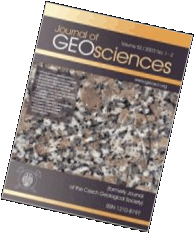 Export to Mendeley
Export to MendeleyOriginal Paper
Brown and blue schorl from the Spiš-Gemer granite, Slovakia: composition and genetic relations
Journal of the Czech Geological Society, volume 43 (1998), issue 1-2, 9 - 16
Schorl is a widespread accessory mineral in Sn-bearing S-type rocks of the Spiš-Gemer granite suite (SGG), E. Slovakia. Schorl content increases from Sn-, B-poor biotite-(muscovite) to highly evolved Sn, B-rich albite-muscovite leucogranite, locally with greisenized parts in granite cupolas. Optical, EMPA and OES data reveal two populations of tourmaline: (1) brown schorl with low X-site vacancy, and (2) X-site deficient blue schorl, enriched in Pb and Sn. A Fe/(Fe + Mg)at ratio varies between 0.75-0.97. The Mössbauer spectra determined Fe3+ <10% for both populations which indicate a low fO2 conditions. Overgrowths of the blue variety on smoky cores and the trace-element chemistry indicate a two-stage evolution of SGG schorl: older brown schorl crystallized during magmatic stage with quartz, feldspars and micas, whereas younger blue schorl originated during late-magmatic to hydrothermal stage and it is a product of breakdown of brown schorl and biotite. Presenve of schorl indicates B-rich protolite in the source rocks of SGG represented by illite- or muscovite-rich marine sediments.
Webdesign inspired by aTeo. Hosted at the server of the Institute of Petrology and Structural Geology, Charles University, Prague.
ISSN: 1803-1943 (online), 1802-6222 (print)
email: jgeosci(at)jgeosci.org


IF (WoS, 2024): 1.3
5 YEAR IF (WoS, 2024): 1.4
Policy: Open Access
ISSN: 1802-6222
E-ISSN: 1803-1943